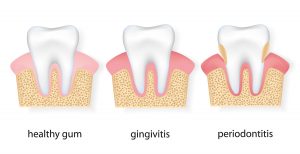Periodontal Disease Treatment for Dental Implants
We perform an oral surgical procedure for Periodontal Disease Treatment, the Bone Graft, which serves to regenerate bone growth that has been lost as a result of the body’s immune system fighting bacterial infections. This month’s blog is dedicated to educating readers about the dangers of gum disease in the hope that you will understand the importance of taking care for your teeth and gums every day before the damage is done and bone must be grafted to allow for the possibility of future dental implants.
What is Periodontal (Gum) Disease?
 Periodontal disease can range from simple gum inflammation to serious disease that results in major damage to the soft tissue and bone that support the teeth. In the worst cases, teeth are lost.
Periodontal disease can range from simple gum inflammation to serious disease that results in major damage to the soft tissue and bone that support the teeth. In the worst cases, teeth are lost.
Gingivitis is the first sign of periodontal disease as plaque and tartar on the teeth cause inflammation of the gums. You will have seen this if your gums have ever become red, swollen and bleed easily. Typically, gingivitis can be reversed with daily brushing and flossing, and regular cleaning by a dentist or dental hygienist. This form of gum disease does not include any loss of bone and tissue that hold teeth in place.
In periodontitis, gums pull away from the teeth and form spaces (called “pockets”) that become infected. Bacterial toxins start to break down the bone and connective tissue that hold teeth in place. If not treated, the bones, gums, and tissue that support the teeth are destroyed. The teeth may eventually become loose and have to be removed.
Risk Factors for Periodontal Disease
While periodontitis typically occurs due to neglect in properly brushing and flossing to remove tartar, along with regular cleanings by a dental hygienist, there are certain groups more likely to suffer from gum disease. These patients should be mindful of the risks and pay extra special attention to their oral health.
Risk factors include:
- Smoking.
- Hormonal changes in girls and women that make the gums more sensitive and give gingivitis an easier time developing.
- Diabetes (people with this are at a higher risk of developing infections overall).
- Treatments for Cancer and AIDS negatively affect the health of your gums.
Prescription Medications that reduce saliva, which has a protective effect on the mouth. - Genetic susceptibility.
- Men are more likely to have gum disease than women.
When should someone be most worried about Periodontal Disease?
The signs of gum disease usually appear when people are in their 30s and 40s. Failure to adopt regular routines of daily brushing and flossing can allow plaque to build up over time along and under the gum line.
The symptoms of gum disease include bad breath impervious to mouthwash, red or swollen gums, tender or bleeding gums, painful chewing, loose teeth, sensitive teeth, or receding gums. A self-examination in the mirror of the gums for signs of inflammation should be check right away by a dentist.
Patients of Ocoee Oral Surgery who require a bone graft for Periodontal Disease Treatment may be referred by a doctor or dentist who recognize the symptoms or risk factors, possibly after taking an X-ray to determine whether there is any bone loss. Whether surgical treatment is needed will depend on how far the disease has progressed.
Drs. Hunter T. McCord, DDS, and Paul T. McCord, DDS, offer treatment options that exceed the capabilities of most regular dentists. In between the diagnosis and the bone graft procedure to allow the placement of dental implants, your regular dentist will almost certainly recommend changing certain behaviors such as smoking to prevent worsening of the gum disease. Keeping up good daily care at home can make a big difference when it comes to preventing tooth loss from periodontal disease.
Before referring patients to oral surgeons like us, periodontal disease treatment may first involve medications and deep-cleaning techniques called scaling and root planning. A prescription mouth rinse containing an antimicrobial called chlorhexidine is commonly a first line of attack for advanced gum disease. A low dose of the medication doxycycline that keeps destructive enzymes in check. Antibiotic tablets or capsules may have a positive effect, as well as antiseptic gelatin chip filled with the medicine chlorhexidine, an antibiotic gel containing doxycycline, tiny particles of minocycline, and/or an enzyme suppressant.
If these medicines and deep-cleaning techniques fail to address the gum disease and bone loss, surgical alternatives may be necessary.
Bone Grafts and Sinus Lift Procedures
Atrophied jawbone associated with missing teeth can leave poor quality or quantity of bone suitable for placement of dental implants. Using bone obtained from a tissue bank or your own bone taken from the jaw, we can grow new bone where needed to place dental implants. The procedure can be used for prepare dental implant sites that have inadequate bone structure for a variety of reasons including previous extractions or injuries as well.
Dental implants need bone to hold them in place, so a sinus graft or sinus lift may be needed to lift the sinus membrane to allow for donor bone to be inserted into the floor of the sinus so that there is additional bone to allow for the placing of dental implants. Over a process of several months, the bone becomes integrated into your jaw.
To schedule a consultation to speak with the Oral Surgeons about bone grafts and sinus augmentation to allow for dental implants to replace teeth lost to periodontal disease, call our Cleveland TN office at (423) 479-8544 or email [email protected]. If you are discussing gum disease with your regular dentist, the doctors can speak with them about a referral to treat you.
